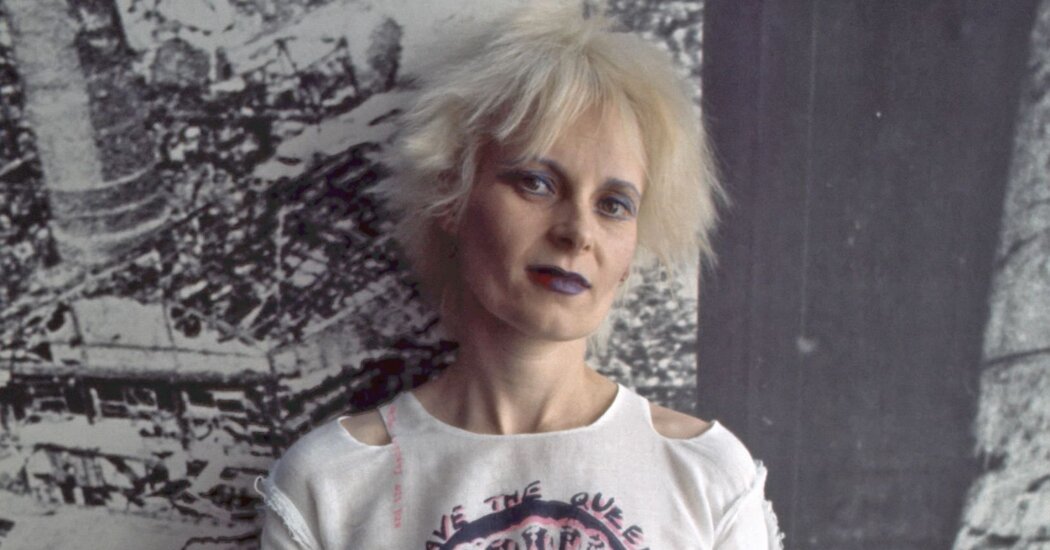Vivienne Westwood, 81, Dies; Brought Provocative Punk Style to High Fashion – The New York Times

The London shop she ran with Malcolm McLaren defined an era. “I don’t think punk would have happened,” Chrissie Hynde said, “without Vivienne and Malcolm.”

Vivienne Westwood, the designer who defined the look of punk, using rock iconography, royalty, art and religion as recurring motifs in collections that brought a rebellious edge to British style, and who later went on to a long career in high fashion, died on Thursday in the Clapham neighborhood of South London. She was 81.
Her death was announced by her company, Vivienne Westwood, which did not specify the cause.
Ms. Westwood was just 30 when she and her boyfriend, Malcolm McLaren — who as a music impresario would go on to manage the Sex Pistols — opened a shop called Let It Rock at 430 King’s Road in London. The business, which had a pink vinyl sign out front, was an unconventional one, selling fetish wear and fashions inspired by the Teddy Boy look of the 1950s.
In shaping the look of the era, Ms. Westwood came to be known as the godmother of punk. After her partnership with Mr. McClaren ended, she began designing collections under her own name, and she soon established an international reputation. She went on to open more stores in London and across the globe; her provocative creations appeared on supermodels and celebrities and influenced mainstream fashion. The corsets, platform shoes and mini-crinis (a combination Victorian crinoline and miniskirt) became her hallmarks.
“People really associate her with punk and that whole aesthetic, which is accurate and how she made her name, but she’s so much more than that,” Véronique Hyland, the author of “Dress Code: Unlocking Fashion From the New Look to Millennial Pink” (2022), said in an interview for this obituary. “She was influenced by art history, old master paintings. She’s very focused on the English tradition of tailoring.”
In a memoir published in 2014 and simply called “Vivienne Westwood,” Ms. Westwood wrote that people “seem surprised still that you can have been in punk and then also be in couture, but it’s all connected.”
“It’s not about fashion, you see,” she wrote. “For me, it’s about the story. It’s about ideas.”
The King’s Road shop always offered a peek inside its proprietors’ obsessions involving class, fashion and propriety. As the years went on, its name frequently changed — it was variously known as Let It Rock; Too Fast to Live, Too Young to Die; Sex; Seditionaries; and World’s End. Its wares frequently changed as well.
Ms. Westwood made the clothes, which might include shirts with cutout photos of pinup girls or studded underwear made from T-shirts with slogans like “destroy” or “Be reasonable, demand the impossible.”
“I did not see myself as a fashion designer but as someone who wished to confront the rotten status quo through the way I dressed and dressed others,” Ms. Westwood said in her memoir, which she wrote with Ian Kelly.
Chrissie Hynde, who would later become the lead singer of the Pretenders, was an assistant at the shop. She was quoted in Ms. Westwood’s memoir as saying that “I don’t think punk would have happened without Vivienne and Malcolm.”
“Something would have happened,” she continued, “and it might have been called punk, but it wouldn’t have looked the way it did, even in America. And the look was important.”
Sometimes the choices made by Ms. Westwood and Mr. McLaren, an art school dropout who was inspired by the theater of the absurd as championed by the French Situationists, could be controversial; they once included swastikas in their designs. (“We were just saying to the older generation, ‘We don’t accept your values or your taboos, and you’re all fascists,’” she later explained.)
They saw the store as a laboratory and a salon. When Mr. McLaren managed the Sex Pistols, Ms. Westwood dressed them in T-shirts from the shop and bondage pants accessorized with chains and razor blades. Their aggressively delivered songs, with names like “Anarchy in the U.K.” and “God Save the Queen,” were a soundtrack to the nihilism of Britain in the 1970s.
“I was about 36 when punk happened and I was upset about what was going on in the world,” Ms. Westwood told Harper’s Bazaar in 2013. “It was the hippies who taught my generation about politics, and that’s what I cared about — the world being so corrupt and mismanaged, people suffering, wars, all these terrible things.”… “And I blamed the older generation for what was going on too,” she added, “so we wouldn’t even accept their taboos. That’s how the swastika symbols came to be used in punk, for example.”
A complete obituary will follow.
Copyright :


